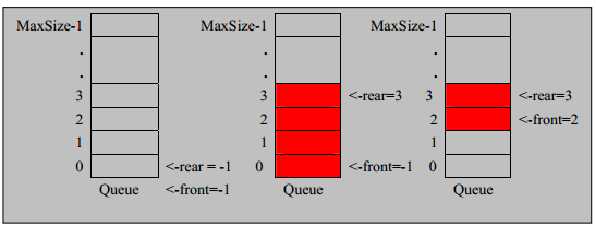C语言之环形队列
Posted r_jw
tags:
篇首语:本文由小常识网(cha138.com)小编为大家整理,主要介绍了C语言之环形队列相关的知识,希望对你有一定的参考价值。
. 一、环形队列的优势
环形队列是一种特殊的队列,它可以解决普通队列在使用时空间利用不充分的问题。在环形队列中,当队列满时,队列的尾指针指向队列的起始位置,而不是指向队列的最后一个元素。这样可以在不浪费空间的情况下存储更多的元素。
下面我们来详细讲解一下环形队列的实现。
. 二、环形队列的定义
首先,我们需要定义一个环形队列的结构体,包含以下成员变量:
-
int *queue:指向环形队列的指针;
-
int front:指向队列的头部;
-
int rear:指向队列的尾部;
-
int size:队列的容量。
typedef struct
int *queue;
int front;
int rear;
int size;
MyCircularQueue;
三、环形队列的初始化
在初始化环形队列时,我们需要为其动态分配内存空间,并将头指针和尾指针都初始化为-1,表示队列为空。
MyCircularQueue* myCircularQueueCreate(int k)
MyCircularQueue *obj = (MyCircularQueue *)malloc(sizeof(MyCircularQueue));
obj->queue = (int *)malloc(sizeof(int) * k);
obj->front = -1;
obj->rear = -1;
obj->size = k;
return obj;
. 四、环形队列的入队
当向队列中插入元素时,我们需要先判断队列是否已满。如果队列已满,则插入失败,返回false;否则,将元素插入到队列的尾部,并将尾指针指向下一个位置。bool myCircularQueueEnQueue(MyCircularQueue* obj, int value)
if (myCircularQueueIsFull(obj))
return false;
obj->rear = (obj->rear + 1) % obj->size;
obj->queue[obj->rear] = value;
if (obj->front == -1)
obj->front = obj->rear;
return true;
. 五、环形队列的出队
当从队列中删除元素时,我们需要先判断队列是否为空。如果队列为空,则删除失败,返回false;否则,将元素从队列的头部删除,并将头指针指向下一个位置。bool myCircularQueueDeQueue(MyCircularQueue* obj)
if (myCircularQueueIsEmpty(obj))
return false;
if (obj->front == obj->rear)
obj->front = -1;
obj->rear = -1;
return true;
obj->front = (obj->front + 1) % obj->size;
return true;
. 六、环形队列的查看队首元素
当查看队列的头部元素时,我们需要先判断队列是否为空。如果队列为空,则返回-1;否则返回队列头部的元素。int myCircularQueueFront(MyCircularQueue* obj)
if (myCircularQueueIsEmpty(obj))
return -1;
return obj->queue[obj->front];
. 七、环形队列的查看队尾元素
当查看队列的尾部元素时,我们需要先判断队列是否为空。如果队列为空,则返回-1;否则,返回队列尾部的元素。int myCircularQueueRear(MyCircularQueue* obj)
if (myCircularQueueIsEmpty(obj))
return -1;
return obj->queue[obj->rear];
. 八、环形队列的判断是否为空
当判断队列是否为空时,只需要判断头指针是否为-1即可。bool myCircularQueueIsEmpty(MyCircularQueue* obj)
return obj->front == -1;
. 九、环形队列的判断是否已满
当判断队列是否已满时,只需要判断尾指针下一个位置是否为头指针即可。bool myCircularQueueIsFull(MyCircularQueue* obj)
return (obj->rear + 1) % obj->size == obj->front;
. 十、环形队列的销毁
当环形队列不再使用时,需要释放其占用的内存空间。void myCircularQueueFree(MyCircularQueue* obj)
free(obj->queue);
free(obj);
总的来说,环形队列是一种非常实用的数据结构,特别适用于空间有限的情况下。通过合理的设计和实现,可以使得队列的空间利用率更高,并且操作效率也比较高。
数据结构之数组模拟队列(单项队列和环形队列)
一、队列的介绍及使用场景
队列是一个有序列表,可以用数组或是链表来实现。
遵循先入先出的原则。即:先存入队列的数据,要先取出。后存入的要后取出
示意图:(使用数组模拟队列示意图)

队列的使用场景:银行排队叫号系统
二、单向队列
队列本身是有序列表,若使用数组的结构来存储队列的数据,则队列数组的声明如下图, 其中 maxSize 是该队列的最大容量。
因为队列的输出、输入是分别从前后端来处理,因此需要两个变量 front及 rear分别记录队列前后端的下标,front 会随着数据输出而改变,
而 rear则是随着数据输入而改变,如图所示:

在队列中有几个参数需要定义:
1) 将尾指针往后移:rear+1 ,当front == rear时,代表队列是空的。
2) 若尾指针 rear 小于队列的最大下标 maxSize-1,则将数据存入 rear所指的数组元素中,
否则无法存入数据。 当rear == maxSize - 1时,代表队列是满的。
实现代码:

/** * 数组列表 */ public class ArrayQueueDemo { public static void main(String[] args) { //测试一把 //创建一个队列 ArrayQueue queue = new ArrayQueue(3); char key = ‘ ‘; //接收用户输入 Scanner scanner = new Scanner(System.in);// boolean loop = true; //输出一个菜单 while(loop) { System.out.println("s(show): 显示队列"); System.out.println("e(exit): 退出程序"); System.out.println("a(add): 添加数据到队列"); System.out.println("g(get): 从队列取出数据"); System.out.println("h(head): 查看队列头的数据"); key = scanner.next().charAt(0);//接收一个字符 switch (key) { case ‘s‘: queue.showQueue(); break; case ‘a‘: System.out.println("输出一个数"); int value = scanner.nextInt(); queue.addQueue(value); break; case ‘g‘: //取出数据 try { int res = queue.getQueue(); System.out.printf("取出的数据是%d ", res); } catch (Exception e) { // TODO: handle exception System.out.println(e.getMessage()); } break; case ‘h‘: //查看队列头的数据 try { int res = queue.headQueue(); System.out.printf("队列头的数据是%d ", res); } catch (Exception e) { // TODO: handle exception System.out.println(e.getMessage()); } break; case ‘e‘: //退出 scanner.close(); loop = false; break; default: break; } } System.out.println("程序退出~~"); } } class ArrayQueue{ private int maxSize;//数组的最大容量 private int front;//队列头 private int rear;//队列尾 private int[] arr;//该数据用来存放数据,用于模拟队列 //创建队列的构造器 public ArrayQueue(int arrMaxSize){ maxSize = arrMaxSize; arr = new int[maxSize]; front = -1;//指向队列头部,front是指向队列的头的前一个位置 rear = -1;//指向队列尾,就是队列最后一个数据 } //判断队列是否满了 public boolean isFull(){ return rear==maxSize-1; } //判断队列是否为空 public boolean isEmpty(){ return front == rear; } //向队列中添加数据 public void addQueue(int n){ if(isFull()){ System.out.println("队列已满,不能添加数据了"); return; } rear++; arr[rear] = n; } //取出队列第一个数据 public int getQueue(){ if(isEmpty()){ throw new RuntimeException("队列为空,不能叫号"); } front++; return arr[front]; } //展示队列中的数据 public void showQueue(){ if(isEmpty()){ System.out.println("队列为空,没有可展示数据"); return; } System.out.print("队列中的数据为:"); for (int i = 0; i < arr.length; i++) { System.out.printf("arr[%d]=%d ",i,arr[i]); } } //查看队列头的数据 public int headQueue(){ if (isEmpty()){ throw new RuntimeException("队列为空"); } return arr[front+1]; } }
三、环形队列
对前面的数组模拟队列的优化,充分利用数组. 因此将数组看做是一个环形的。(通过取模的方式来实现即可)
尾索引的下一个为头索引时表示队列满,即将队列容量空出一个作为约定,这个在做判断队列满的 时候需要注意 (rear + 1) % maxSize == front [满]
rear == front [空]
思路如下:
1. front 变量的含义做一个调整: front 就指向队列的第一个元素, 也就是说 arr[front] 就是队列的第一个元素 front 的初始值 = 0
2. rear 变量的含义做一个调整:rear 指向队列的最后一个元素的后一个位置. 因为希望空出一个空间做为约定. rear 的初始值 = 0
3. 当队列满时,条件是 (rear + 1) % maxSize == front 【满】
4. 对队列为空的条件, rear == front 空
5. 当我们这样分析, 队列中有效的数据的个数 (rear + maxSize - front) % maxSize // rear = 1 front = 0
6. 我们就可以在原来的队列上修改得到,一个环形队列
代码实现:

public class CircleArrayQueueDemo { public static void main(String[] args) { //测试一把 //创建一个队列 CircleArrayQueue queue = new CircleArrayQueue(3); char key = ‘ ‘; //接收用户输入 Scanner scanner = new Scanner(System.in);// boolean loop = true; //输出一个菜单 while(loop) { System.out.println("s(show): 显示队列"); System.out.println("e(exit): 退出程序"); System.out.println("a(add): 添加数据到队列"); System.out.println("g(get): 从队列取出数据"); System.out.println("h(head): 查看队列头的数据"); key = scanner.next().charAt(0);//接收一个字符 switch (key) { case ‘s‘: queue.showQueue(); break; case ‘a‘: System.out.println("输出一个数"); int value = scanner.nextInt(); queue.addQueue(value); break; case ‘g‘: //取出数据 try { int res = queue.getQueue(); System.out.printf("取出的数据是%d ", res); } catch (Exception e) { // TODO: handle exception System.out.println(e.getMessage()); } break; case ‘h‘: //查看队列头的数据 try { int res = queue.headQueue(); System.out.printf("队列头的数据是%d ", res); } catch (Exception e) { // TODO: handle exception System.out.println(e.getMessage()); } break; case ‘e‘: //退出 scanner.close(); loop = false; break; default: break; } } System.out.println("程序退出~~"); } } class CircleArrayQueue{ private int maxSize;//数组的最大容量 //front 变量的含义做一个调整: front 就指向队列的第一个元素, 也就是说 arr[front] 就是队列的第一个元素 //front 的初始值 = 0 private int front; //rear 变量的含义做一个调整:rear 指向队列的最后一个元素的后一个位置. 因为希望空出一个空间做为约定. //rear 的初始值 = 0 private int rear; private int[] arr;//该数据用来存放数据,用于模拟队列 //创建队列的构造器 public CircleArrayQueue(int arrMaxSize){ maxSize = arrMaxSize; arr = new int[maxSize]; } //判断队列是否满了 public boolean isFull(){ return (rear + 1) % maxSize == front; } //判断队列是否为空 public boolean isEmpty(){ return front == rear; } //向队列中添加数据 public void addQueue(int n){ if(isFull()){ System.out.println("队列已满,不能添加数据了"); return; } arr[rear] = n; rear = (rear + 1) % maxSize; } //取出队列第一个数据 public int getQueue(){ if(isEmpty()){ throw new RuntimeException("队列为空,不能叫号"); } int val = arr[front]; front = (front + 1) % maxSize; return val; } //展示队列中的数据 public void showQueue(){ if(isEmpty()){ System.out.println("队列为空,没有可展示数据"); return; } System.out.print("队列中的数据为:"); for (int i = front; i < front + size(); i++) { System.out.printf("arr[%d]=%d ",i%maxSize,arr[i%maxSize]); } } //统计数列中有效的数据个数 public int size(){ return (rear + maxSize - front) % maxSize; } //查看队列头的数据 public int headQueue(){ if (isEmpty()){ throw new RuntimeException("队列为空"); } return arr[front]; } }
以上是关于C语言之环形队列的主要内容,如果未能解决你的问题,请参考以下文章
